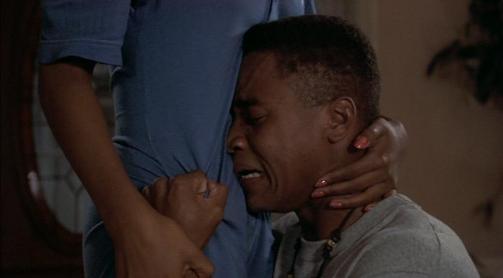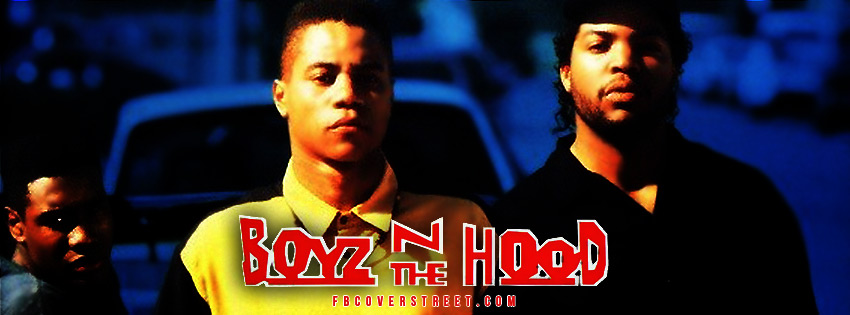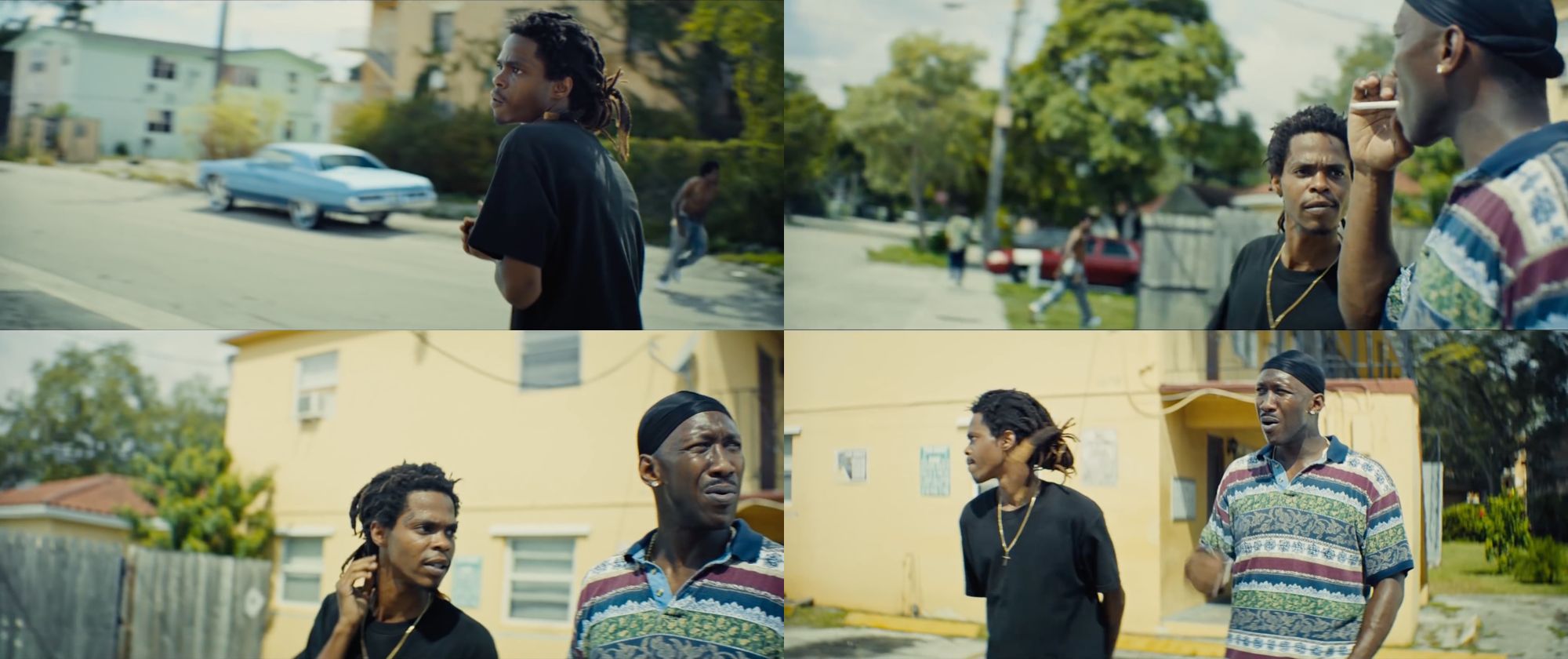'Boyz N the Hood' is a movie examining the social issues and experiences of three friends that grew up in a Los Angeles ghetto. The film takes place in 1985, and then flashes seven years into the future to 1992. The film follows Tre Styles, an intelligent ten-year old who was aggressive and immature in his early school years. As a result of his hot temper, his mother, Reva (Angela Bassett), sent him to live with his father, Furious (Laurence Fishburne), who proves to be stricter and more watchful
than his mother.
Dropping her son Tre off , Reva tells Furious, “I can’t teach him how to be a man; it’s your job.”: the quote suggests a singular type of masculinity, the film contests this notion, showing differing masculine role models and boys’ attempts for achieving manhood. In the process, it converses popular white notions of black masculinities and lifestyles, brought by Reva as she denounces Tre’s white teacher for suggesting Tre's problems were rooted in family instability, such as parental unemployment and an absentee father. Here, she separates her family from these stereotypes and suggests multiple experiences rather than one unified under a singular conception of a “black” lifestyle.

Throughout the film’s childhood sequence, Furious focuses on keeping Tre out of the harsh street life and teaches him how to be a true man, not the masculine male image young black men are all too familiar with. In fact, the first night that Tre is with his father, Furious shoots at and misses a burglar.
Furious renounces building his masculinity on sex and violence, trying to teach his son the power of respect, in part gained through responsibility. This proves difficult as from a young age, the boys see and react to men’s power with physical violence. For emxample, the boys lose their ball to physically stronger older boys and, unable to defeat them physically, one of the boys keeps repeating he wants to “kill that m*therf*cker.” The boys find themselves caught in hierarchy based on violence whose effects they cannot escape. Two choices offered by Furious: either add to the violence and problems of the neighbourhood or not.
Most choose the former, expanding their sense of masculinity through sex. One example would be a dramatic highlight of the film in which Tre tells his father with details of a sexual tryst which, along with the dangerous gunplay, acts as another, sweeter example of mis-channelled machismo.


Also, demonstrated in the barbecue scene and the following dialouge amongst the characters, a lack of education around sex as well as stigmatization of virginity flourishes in the hood, with babies and STIs following in its wake. A comparison can be made to Doughboy’s references to women as ho, bitch, hootchie, etc. with bell hooks’ conception of black phallocentric masculinity, which hooks conceives of as “a phallocentric model, where what the male does with his penis becomes a greater and certainly a more accessible way to assert his male status” . Hardened by jail time and adamant to reassert his fearsome reputation on neighbourhood foes, he talks and acts violently, but in a manner that’s entirely nonchalant. Forceful aggression is so ingrained within him that basic civility now seems quaint. When he refers to women as “bitches” and “hoes”, it’s not because he wants to, but because he has to.

Throughout the film, the narrative follows Tre's struggles with this dilemma of how to respond to male aggression. In one moving scene, he reaches the pinnacle of his frustrations and starts punching the air in front of his girlfriend. Impotent to affect an immediate change in his situation, he cries in front of her, at first embarrassed as it goes against his friends’ ideas of maintaining a powerful persona and position toward women. However, not responding rashly by adding to the aggression, he enacts his father’s vision of masculinity, which is followed by a symbolic second step towards enacting a masculinity—responsible sex with his girlfriend. Importantly, he does so sensitively, and, when she expresses a fear of pregnancy, he tells her not to worry—the audience is left to infer that he is using a condom as taught by his father, reinforcing resistance to black masculinity.

Black culture was both embraced and criticised in this film. Singleton celebrated certain aspects of African American inner-city culture, such as the closeness in community and family. However, despite a strong sense of empathy, the criticisms of the violent culture of the Los Angeles ghetto outweigh the positives in the film. The objective was to reveal the constant cycle of murder and the self-fulfilling prophecy due to the pressures of masculinity. In order to do this, Singleton risks reinforcing the stereotype that young black males are violent. Whether or not stereotypes exist in this film is purely subjective, because, for example, Singleton portrays the reality of “the Hood,” but an outsider may view it was stereotypical. Race politics and arguments are inevitably implied, because Singleton’s film addresses societal problems related to race specifically. Police brutality is a sub-issue alluded to in the film through two scenes involving a black cop abusing his authority and threatening the young black males. For example, a cop pulled Tre and Ricky over and the black cop presses his loaded gun to Tre’s neck while verbally threatening him. Scenes like this one bring up serious societal problems surrounding race.
A lot of characters in Moonlight assume that masculinity means asserting dominance. Kevin is the first example of this, playing up to an image of a heterosexuality that practically comes across as parody. A similarly humorous sequence occurs in Boyz n the Hood, when Tre (Cuba Gooding Jr) tries to impress his dad with a phony story about a sexual conquest. Kevin attempts to keep up appearances are desperate, especially during a scene on a beach with Chiron. Following the near-admission that he cries, he backtracks and responds: “Nah. I wish I did.” It’s almost comical that even in a scene as intimate as this, Kevin feels the need to maintain his hyper-masculine facade.
Moonlight and Boyz n the Hood may be vastly different in style and tone, but there’s enough re occurring themes for these films to be considered companion pieces of sorts. They are personal, unique and honest explorations of the connection between the hostile environments that young African-American men are met with, and how they respond.
=======================================================
'BEAR'(1993) dir. Steve McQueen

Bear, is a 10 minutes long, silent, and consisted of two naked men, one of them him, wordlessly circling each other, staring and sparring, Steve McQueen's first major film. From looking at articles the video raises sensitive issues about race, homoeroticism and violence. It depicts two naked men-one of which is the artist-sparing and teasing one another in a confrontation which goes from tenderness and aggression. The film is silent but a series of stares, glances and winks between the protagonists "creates an optical language of flirtation and threat."(Tate)
The film opens with a close-up, a cinematic convention, shot of one man's shoulder. The camera then moves slowly upwards and to the right, travelling his face with close proximity that suggesting the camera is feeling across the dents of his face. I think, McQueen may reinforce the idea of the sexuality Black male bringing into the idea of Black men being seen as sexualised objects rather than humans, at certain points, medium shots revealing underneath of the men showing their genitalia maybe to reinforce such ideas but also subvert them as Black men aren't able to freely be open with their sexuality or ability to be intimate sexually or platonic with other men- a sexual empowerment of Black men not represented in culture.
Throughout the film, the disorientating camerawork and silent movement of the two bodies moving across a shaft of light, adds to the existing sense of ambiguity. The ability to have the two characters, black males, moving around caressing each other but also fighting one another playfully depicts the on going relationship of Black men and the inability to not allow the society to justify their own identity, extending into a refusal to appear vulnerable, ‘feminine’ or just plain weird. both Jenkins and Singleton provide a similar answer: it’s not about adhering to or performing specific gender stereotypes, but rather a feeling of independence, and the right to choose a life for one’s self. This would reinforce the idea of McQueen's need to have the video play in an empty space quite and lilting . McQueen states in an interview: "You are very much involved in what's going on. You are a participant not a passive viewer," and concerning the disconcerting sound of 'Bear' he states "The whole idea of making it a silent piece is so that when people walk into the space they become very much aware of themselves, of their own breathing,"
The viewer is left to watch the scene with the intentions of making their own images and ideas of what it is trying to communicate but the main idea is the two characters are in a world of their own and created their own identifies and unnerved from that of onlookers: "I want to put people into a situation where they're sensitive to themselves watching the piece"
=======================================
'Blaxploitation' genre (1970s)
The genre emerged in the 1970's in the United States and is a hybrid word using Black and exploitation. It targeted urban Black audiences and switched roles from the norm from the general white characters but making them villains and having Black heroes making it socially and politically conscious of it's time. There was the general stereotypes, which did exist, urban setting, drugs , prostitution but also social injustice, racial discrimination, brutality of the police.
Male character in Blaxploitation films characterised as:
-Hypermasculinity
-Virility
-Macho black hero
-Well-dressed
-Sexual prowess
-Sexual empowerment of black men in mainstream culture
-The hero fights against injustice (and/or white men) outside of the legal mechanisms
-Macho black hero
-Well-dressed
-Sexual prowess
-Sexual empowerment of black men in mainstream culture
-The hero fights against injustice (and/or white men) outside of the legal mechanisms
'Shaft'(1971) dir. Gordon Parks

'Shaft' follows a fairly conventional noir plot. Shaft is hired by local mob boss Bumpy Jonas (Moses Gunn) to find Bumpy’s kidnapped daughter – though not until Shaft has made it clear that he despises everything Bumpy stands for (he tosses one of Bumpy’s men out a window to get the message across). Similarly, the case brings him in contact with a Black Panther-like militant group that he also scoffs at. Shaft is seen to only serves no cause but his own. Even so, he ultimately becomes a uniting force, bringing both of these factions together to face a new enemy threatening the neighborhood: the Italian mafia. This is where the movie’s enlightenment ends, as well as its provocative headiness. The final third follows a well-worn action pattern, with Shaft, of course, taking the lead.

The picture’s final shot is of Shaft walking alone down the street, offering a bookend of sorts with the walk he took over the opening credits. On that earlier stroll, he passes movie marquees boasting names like Robert Redford and Dean Martin. Shaft saunters right on by, leaving those stars behind, He’s taking us into a whole new era.
This film regales itself on worshipping its central figure (played with an easy smile and an easier scowl by Richard Roundtree). Isaac Hayes’ Oscar-winning title song sings Shaft’s praises over the opening credits. When he struts across six lanes of New York City traffic, the cars give him the right of way. The first sex scene barely notices the woman on hand: it’s Shaft who poses nude on the couch; it’s Shaft’s (much darker) skin that the camera lingers on; it’s a framed photo of Shaft that the camera drifts toward as the couple goes about their business.

The film is flashy and does posses the traits of using Black people to subvert the images normally seen in noir films, as instead of white actors being seen as the heroes they are the villains and it is a Black man who is put as the protagonist of the film, serving his own justice to crooks and immoral police officers. However, the film still olds notable traits of stereotypes of a Black man as Shaft himself is over bearing and dominating common traits represented on Black men , after slavery, the idea held of Black men of just being seen as bodies is evident, since slavery, Black men have been seen as scary and big which is why many were able to hung and killed just for simply being these traits or even not being evidently masculine (as they were killed too), this maybe due to the director being a whote man representing an image of a Black man, rather than it being a black man as seen in 'Boyz N the Hood' and 'Moonlight'.
In the documentary, 'Black Hollywood', Jim Brown discusses that blaxploitation films that were under white control and production took advantage of the black audience and black actors, in order to create cheaply produced films which often perpetuated stereotypical images of black men and women; which is evident in 'Shaft'. The ability to just not conform to those stereotypes of Black men isn't seen in many Blaxploitation films because of their time, though flashy and different, they do not refrain from commenting on Black men as overly masculine, scary and angry. Robert Staples in his book 'Black masculinity' writes an explanation on how Black masculinity have been influenced and created throughout history. He explains how black men in the US have been unable to earn the same patriarchal privileges attached with the status of being males because of their racial identity.
“Black men face certain problems related to institutional 9 racism and environments which often do not prepare them very well for the fulfillment of masculine roles. In addition to the problems created by institutional and overt discrimination, they encounter negative stereotyping that exists on all levels about them: being socially castrated, insecure in their male identity, and lacking in a positive self concept”(Staples, 1982:8) Staples concept of the problems black men face helps to show that blaxploitation films worked to perpetuate stereotypical images of black men.
As white masculinity is dominate in our society and thus makes inferior of marginalised types of masculinity, like black masculinity and female masculinity. “Hegemonic masculinity among whites sustains the institutional oppression and physical terror that have framed the making of masculinity in black 6 communities” (Connell, 1995:80). Connell explains here of the difference between hegemonic masculinity vs. marginalised masculinity and could be used as a way in which blaxploitation films were influences by hegemonic white masculinity to produce the marginalised masculinity show in the films .






